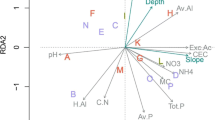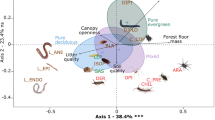Abstract
Amazonian forests in black-water floodplains (igapó) and upon hydromorphic white-sand soils (campinarana) cover at least 500,000 km2 of the area of the Amazon basin, but are poorly investigated ecosystems. We compared variation in tree species richness and composition (≥ 10 cm diameter at breast height), as well as forest structure and aboveground wood biomass (AGB) along hydroedaphic gradients in an igapó and a campinarana in the central Brazilian Amazon, in an area totalling 6 ha. Inundation height (igapó) and groundwater level oscillations (campinarana) were monitored during a one year period. Soil grain sizes and chemical variables were analysed. Variation in tree species composition was assessed using non-metric multidimensional scaling, and soil parameters using principal component analysis. The influence of hydroedaphic gradients on tree species richness, composition and AGB was investigated using partial and multiple regression analyses. Significant differences in soil texture, soil chemical variables, and tree species richness and composition were detected between both forest types, while AGB amounted to similar values, ranging from 141 ± 62 Mg·ha−1 in the igapó to 164 ± 121 Mg·ha−1 in the campinarana. Although both forest types were floristically distinct, inundations in the igapó and groundwater table oscillations in the campinarana influenced patterns of species richness and forest structure in similar ways, indicating decreasing species richness, forest stature and AGB in plots subjected to higher inundations and/or groundwater levels. Given the comparatively low AGB in the ecosystems studied, we call attention to the need for more studies in oligotrophic ecosystems of the Amazon basin with emphasis on their contribution to global carbon cycles.





Similar content being viewed by others
References
Baker TR, Phillips OL, Malhi Y et al. (2004a) Increasing biomass in Amazonian forest plots. Philos Trans, Ser B 359:353–365
Baker TR, Phillips OL, Malhi Y et al. (2004b) Variation in wood density determines spatial patterns in Amazonian forest biomass. Global Change Biol 10:545–562
Baraloto C, Rabaud S, Molto Q et al. (2011) Disentangling stand and environmental correlates of aboveground biomass in Amazonian forests. Global Change Biol 17:2677–2688
Barbosa RI, Ferreira CAC (2004) Biomassa acima do solo de um ecossistema de “campina” em Roraima, norte da Amazônia Brasileira. Acta Amazon 34:577–586
Bray JR, Curtis JT (1957) An Ordination of the Upland Forest Communities of Southern Wisconsin. Ecol Monogr 27:325–349
Brown S (2002) Measuring, monitoring, and verification of carbon benefits for forest-based projects. Philos Trans, Ser A 360:1669–1683
Cannel MGR (1984) Woody biomass of forest stands. Forest Ecol Managem 8:299–312
Centro Estadual de Unidades de Conservação (CEUC) (2009) Coletânia de Unidades de Conservação no Estado do Amazonas: leis, decretos e portarias. CEUC/SDS
Chave J, Andalo C, Brown S, et al. (2005) Tree allometry and improved estimation of carbon stocks and balance in tropical forests. Oecologia 145:87–99
Coomes DA (1997) Nutrient status of Amazonian caatinga forests in a seasonally dry area: nutrient fluxes in litter fall and analyses of soils. Canad J Forest Res 27:831–839
Curtis JT, McIntosh RP (1951) An upland forest continuum in the prairie-forest border region of Wisconsin. Ecology 32:476–496
Damasco G, Vicentini A, Castilho CV et al. (2013) Disentangling the role of edaphic variability, flooding regime and topography of Amazonian white-sand vegetation. J Veg Sci 24:384–394
DeWalt SJ, Chave J (2004) Structure and biomass of four lowland Neotropical forests. Biotropica 36:7–19
Embrapa-Empresa Brasileira de Pesquisa Agropecuária (1997) Manual de Métodos de Análise de Solo. Centro Nacional de Pesquisa d Solos, Rio de Janeiro
Fearnside PM (1997) Wood density for estimating forest biomass in Brazilian Amazonia. Forest Ecol Managem 90:59–87
Ferreira LV (1997) Effects of the duration of flooding on species richness and floristic composition in three hectares in the Jaú National Park in floodplain forests in central Amazonia. Biodivers & Conservation 6:1353–1363
Fine PVA, Mesones I, Coley PD (2004) Herbivores promote habitat specialization by trees in Amazonian forests. Science 305:663–665
Fine PVA, García-Villacorta R, Pitman NCA, et al. (2010) A floristic study of the white-sand forests of Peru. Ann Missouri Bot Gard 97:283–305
Fisher AA, Corbet AS, Williams CB (1943) The relation between the number of species and the number of individuals in a random sample of an animal population. J Anim Ecol 12:42–58
Frangi JL, Lugo AE (1985) Ecosystem dynamics of a subtropical floodplain forest. Ecol Monogr 55:351–369
Haugaasen T, Peres CA (2006) Floristic, edaphic and structural characteristics of flooded and unflooded forests in the lower Rio Purus region of central Amazonia, Brazil. Acta Amazon 36:25–36
Houghton RA, Skole DL, Nobre CA, et al. (2000) Annual fluxes from carbon from deforestation and regrowth in the Brazilian Amazon. Nature 403:301–304
Hougton RA, Lawrence KT, Hackler JL, Brown S (2001) The spatial distribution of forest biomass in the Brazilian Amazon: A comparison of estimates. Global Change Bio 7:731--746
Houghton RA (2005) Aboveground forest biomass and the global carbon balance. Global Change Biol 11:945–958
Hultine KR, Dudley TJ, Leavitt SW (2013) Herbivory-induced mortality increases with radial growth in an invasive riparian phreatophyte. Ann Bot 111:1197–1206
IBGE (2012) Mapas Temáticos. Available at www.mapas.ibge.gov.br/tematicos
Junk WJ, Bayley PB, Sparks RE (1989) The flood pulse concept in river-floodplain systems. Canad Spec Publ Fish Aquatic Sci 106:110–127
Junk WJ, Piedade MTF, Schöngart J, et al. (2011) A classification of major naturally-occurring Amazonian lowland wetlands. Wetlands 31:623–640
Klinge H, Herrera R (1983) Phytomass structure of natural plant communities on spodosols in southern Venezuela: The tall Amazon Caatinga forest. Vegetatio 53:65–84
Klinge H, Medina E (1979) Rio negro caatingas and campinas, Amazonas States of Venezuela and Brazil. In: Specht RL (ed) Heatlands and related shrublands. Ecosystems of the world. Vol. 9a. Elsevier Amsterdam, pp 483–488
Kubitzki K (1989) The ecogeographical differentiation of Amazonia inundation forests. Plant Syst Evol 162:285–304
Laurance WF, Fearnside PM, Laurance SG et al. (1999) Relationship between soils and Amazon forest biomass: a landscape-scale study. Forest Ecol Managem 188:127–138
Malhi Y, Baker TR, Phillips OL et al. (2004) The above-ground coarse wood productivity of 104 neotropical forest plots. Global Change Biol 10:563–591
Malhi Y, Wood D, Baker TR et al. (2006) The regional variation of aboveground live biomass in old-growth Amazonian forests. Global Change Biol 12:1107–1138
Medina E, Sobrado M, Herrera R (1978) Significance of leaf orientation for leaf temperature in an Amazonian sclerophyll vegetation. Radiat Environm Biophys 15:131–140
Mitch WJ, Gosselink JG (2000) Wetlands, 4th edition. Wiley, New York
Melack JM, Hess LL (2010) Remote sensing of the distribution and extent of wetlands in the Amazonian basin. In: Junk WJ, Piedade MTF, Wittmann F et al. (eds) Amazonian floodplain forests: ecophysiology, biodiversity and sustainable management. Springer New York, pp 43–59
Nebel G, Kvist LP, Vanclay JL, et al. (2001) Structure and floristic composition of flood plain forests in the Peruvian Amazon I. Overstorey. Forest Ecol Managem 150:27–57
Paoli GD, Curran LM, Slik JWF (2008) Soil nutrients affect spatial patterns of aboveground biomass and emergent tree density in southwestern Borneo. Oecologia 155:287–299
Parolin P, De Simone O, Haase K et al. (2004) Central Amazonian floodplain forests: tree adaptations in a pulsing system. Bot Rev 70:357–380
Parolin P, Lucas C, Piedade MTF, et al. (2009) Drought responses of flood-tolerant trees in Amazonian floodplains. Ann Bot 105:129–139
Prance GT (1975) Estudos sobre a vegetação das Campinas Amazônicas – I. Introdução a uma série de publicações sobre a vegetação das Campinas Amazônicas. Acta Amazon 5:207–209
Prance GT, Daly D (1985) Brazilian Amazon. In: Campbell DG, Hammond HD (eds) Floristic inventory of tropical countries. New York Botanical Garden Press, pp 523–533
Quesada CA, Lloyd J, Schwarz M, et al. (2010) Variations in chemical and physical properties of Amazon forest soils in relation to their genesis. Biogeosciences 7:1515–1541
R Development Core Team (2011) R: A Language and Environment for Statistical Computing. Vienna, Austria: the R Foundation f Statistical Computing. ISBN: 3-900051-07-0. Availabe online at http://www.R-project.org/.
Saatchi SS, Houghton RA, Dos Santos Alvalá RC, et al. (2007) Distribution of aboveground live biomass in the Amazon basin. Global Change Biol 13:816–837
Schöngart J, Piedade MTF, Wittmann F, et al. (2005) Wood growth patterns of Macrolobium acaciifolium (Benth.) Benth. (Fabaceae) in Amazonian black-water and white-water floodplain forests. Oecologia 145:454–461
Schöngart J, Wittmann F, Worbes M (2010) Biomass and net primary production of Central Amazonian floodplains forests. In: Junk WJ, Piedade MTF, Wittmann F et al. (eds) Amazonian floodplain forests: ecophysiology, biodiversity and sustainable management. Springer New York, pp 347–388
Schöngart J, Arieira J, Felfili Fortes C, et al. (2011) Age-related and stand-wise estimates of carbon stocks and sequestration in the aboveground coarse wood biomass of wetland forests in the northern Pantanal, Brazil. Biogeosciences 8:3407–3421
Sioli H (1954) Beiträge zur regionalen Limnologie des Amazonasgebietes. Arch Hydrobiol 45:267–283
Sollins P (1998) Factors influencing species composition in tropical lowland rain forest: Does soil matter? Ecology 79:23–30
Stropp J, Van Der Sleen P, Assunção PA, et al. (2011) Tree communities of white-sand and terra-firme forests of the upper Rio Negro. Acta Amazon 41:521–544
Takeuchi M (1960) A estrutura da vegetação na Amazônia: III – A mata de campina na região do rio Negro. Bol. Mus. Paraense “Emilio Goeldi” 8:1–13
Veloso HP, Rangel Filho ARL, Lima JCA (1991) Classificação da vegetação Brasileira, adaptada a um sistema universal. Fundação Instituto Brasileiro de Geografia e Estatística, Rio de Janeiro
Vicentini A (2004) A vegetação ao longo de um gradiente edáfico no Parque Nacional do Jaú. In: Borges SH, Iwanaga S, Durigan CC, Pinheiro MR (eds) Janelas para a biodiversidade no Parque Nacional do Jaú: uma estratégia para o estudo da biodiversidade na Amazônia. Fundação Vitória Amazônica/WWF/IBAMA Manaus, pp 117–143
Wittmann F, Junk WJ (2003) Sapling communities in Amazonian white-water forests. J Biogeogr 30:1533–1544
Wittmann F, Junk WJ, Piedade MTF (2004) The várzea forests in Amazonia: flooding and the highly dynamic geomorphology interact with natural natural forest succession. Forest Ecol Managem 196:199–212
Wittmann F, Parolin P (2005) Aboveground roots in Amazonian floodplain trees. Biotropica 37:609–619
Wittmann F, Zorzi BT, Tizianel FAT, et al. (2008) Tree species composition, structure and aboveground wood biomass of a riparian forest of the lower Miranda River, Southern Pantanal, Brazil. Folia Geobot 43:397–411
Wittmann F, Schöngart J, Junk WJ (2010) Phytogeography, species diversity, community structure and dynamics of Central Amazonian floodplain forests. In: Junk WJ, Piedade MTF., Wittmann F et al. (eds) Amazonian floodplain forests: ecophysiology, biodiversity and sustainable management. Springer New York, pp 61–102
Wittmann F, Householder E, Piedade MTF et al. (2013) Habitat specifity, endemism and the neotropical distribution of Amazonian white-water floodplain trees. Ecography 36:690–707
Worbes M (1989) Growth rings, increment and age of tree in inundation forest, savannas and a mountain forest in the Neotropics. I A W A Bull 10:109–122
Worbes M (1997) The forest ecosystem of the floodplains. In: Junk WJ (ed) The central Amazon floodplain: ecology of a pulsing system. Springer New York, pp 223–265
Zanchi FB, Waterloo MJ, Dolmann AJ et al. (2011) Influence of drainage status on soil and water chemistry, litter decomposition and soil respiration in central Amazonian forests on sandy soils. Rev Amb Água 6:6–29
Acknowledgements
This work was performed within the frame of the German-Brazilian ATTO project and supported by the federal governments (grant No. MCTI-FINEP 1759/10; grant No. BMBF 01LB1001A). We acknowledge the fundamental support by the Max Planck Society, INPA and UEA. We thank the Amazonas State SDS/CEUC-RDS Uatumã, MAUA Group (Monitoring of Amazonian Wetlands, INPA/Max Planck, Manaus, Brazil) and CAPES.
Author information
Authors and Affiliations
Corresponding author
Appendix 1
Appendix 1
Rights and permissions
About this article
Cite this article
Targhetta, N., Kesselmeier, J. & Wittmann, F. Effects of the hydroedaphic gradient on tree species composition and aboveground wood biomass of oligotrophic forest ecosystems in the central Amazon basin. Folia Geobot 50, 185–205 (2015). https://doi.org/10.1007/s12224-015-9225-9
Received:
Revised:
Accepted:
Published:
Issue Date:
DOI: https://doi.org/10.1007/s12224-015-9225-9




